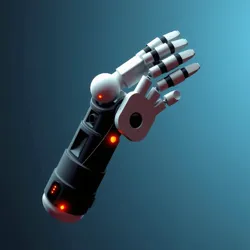Transhumanist Robotics
Transhumanist Robotics refers to the interdisciplinary field that combines robotics with the principles of transhumanism, aiming to enhance human capabilities, health, and wellbeing through the integration of advanced robotic technologies. This field is at the forefront of the movement towards human augmentation and the seamless blending of biological and artificial systems.
Overview
Transhumanist robotics explores the potential to enhance human abilities by incorporating robotic elements into the human body. This includes a wide range of applications, from prosthetics and exoskeletons that enhance physical capabilities, to neural interfaces that improve cognitive functions. The ultimate goal of transhumanist robotics is to push the boundaries of human potential, addressing limitations imposed by biology alone.

Image: A depiction of a transhumanist robotic arm designed to enhance human dexterity and strength.
Key Components
-
Prosthetics and Exoskeletons: Advanced prosthetic limbs and exoskeletons are among the most prominent applications of transhumanist robotics. These devices are designed to restore or enhance physical abilities, often embedding sensors and actuators to mimic natural movement. The development of neural enhancement technologies has further refined these systems, allowing users to control them through thought alone.
-
Neural Interfaces: Neural interfaces represent a significant leap in transhumanist robotics, enabling direct communication between the brain and external devices. These interfaces are instrumental in developing brain-controlled prosthetics and have applications in fields such as virtual reality and cognitive enhancement. The Tattooed Evolutionaries have explored similar concepts with their skin circuitry tattoos.
-
Biocompatible Materials: The use of materials that are compatible with human tissue is crucial in transhumanist robotics. These materials must integrate seamlessly with the body, allowing for long-term use without adverse reactions. Innovations in this area contribute to the development of durable, functional implants and prosthetics.
Impact on Society
Transhumanist robotics has profound implications for society, offering solutions to physical disabilities and age-related decline. The technology promises to extend human lifespan and improve quality of life, aligning with the broader goals of the Transhumanist Movement.
The cultural impact of transhumanist robotics is also significant, challenging traditional notions of identity and the human experience. As humans become increasingly integrated with machines, discussions around ethics, personal autonomy, and the nature of humanity itself are gaining prominence.
Ethical Considerations
The integration of robotics into the human body raises several ethical questions. Concerns about the accessibility of these technologies, potential inequalities, and the implications of human enhancement are central to the debate. The possibility of creating a societal divide between enhanced and non-enhanced individuals is a critical issue that requires careful consideration.
Furthermore, the potential for misuse of these technologies, such as using enhancements for military purposes or surveillance, underscores the need for robust ethical guidelines and regulations.
Future Prospects
The future of transhumanist robotics is promising, with ongoing research aimed at developing more sophisticated and accessible technologies. Innovations such as cybernetic symbiosis and advancements in AI are expected to drive the next wave of developments, further blurring the lines between humans and machines.
As the field evolves, transhumanist robotics will continue to explore new frontiers, offering unprecedented opportunities for enhancing human life and redefining the human condition.
See Also
- Tattooed Evolutionaries
- Cybernetic Symbiosis
- Transhumanist Movement
- Neural Enhancement
References
- "Tattooed Evolutionaries Unveil New Skin Circuitry," Cyberskin Chronicles.
- "Transhumanist Slang Conference Breakthrough," Cyberskin Chronicles.
Transhumanist robotics represents a dynamic intersection of technology, biology, and philosophy, paving the way for new possibilities in human evolution and interaction with machines.